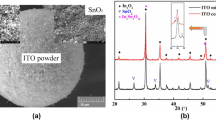Abstract
The rapid growth of crystals after formation of closed pores begins in a sintered intermediate product is explained with the premises of the chemistry of crystals with defects and synergistics. The change in the structure of an infinite cluster of open pores as they are converted to closed pores decreases the concentration barrier of vacancies that prevent diffusion transfer through the boundaries and growth of the crystals. The nonisometric shape of the crystals and high rate of diffusion mass transfer promote the anomalous growth. The easy deformability of the boundaries of the crystals can lead to slight adjustment of their crystallographic orientations and joining of the crystals, which ensures their anomalously rapid growth.
Similar content being viewed by others
References
E. S. Lukin, “Current High-density oxide ceramic with adjustable microstructure. Part III: Microstructure and recrystallization processes in ceramic oxide materials,” Ogneup. Tekh. Keram., No. 6, 2–9 (1996).
J. R. Groza and R. J. Dowding, “Nanoparticulate materials densification,” Nanostructured Mater., 7(7), 749–768 (1996).
V. S. Bakunov and A. V. Belyakov, “Role of structural characteristics in high-temperature creep of ceramics,” Ogneup. Tekh. Keram., No. 10, 17–24 (2000).
Y-M. Chiang, D. P. Birnie III, and W. D. Kingery, Physical Ceramics. Principles for Ceramic Science and Engineering, Wiley, New York, Chichester, Toronto, Brisbane, Singapore (1997).
Barium Titanate Semiconductors [Russian translation], Énergoizdat, Moscow (1982).
B. Guillaumea, F. Boschinia, I. Garcia-Canoa, et al., “Optimization of BaZrO3 sintering by control of the initial powder size distribution; a factorial design statistical analysis,” Eur. Ceram. Soc., 25, 3593–3604 (2005).
I. Prigogine and I. Stengers, Order out of Chaos, Bantam, New York, Bantam (1984).
V. S. Bakyunov and A. V. Belyakov, “Prospects for increasing the reproducibility of the structure and properties of ceramics,” Ogneup. Tekh. Keram., No. 2, 16–21 (1998).
A. V. Belyakov, “Synergistic and quasichemical approaches to ceramics technology,” Steklo Keram., No. 9, 21–27 (2003).
A. V. Belyakov and E. S. Lukin, “Physicochemical principles of production of powders of solid solutions and complex oxides,” in: Proc. of the MKhTI im. D. I. Mendeleeva [in Russian], Issue 147, Moscow (1987), pp. 5–17.
R. A. Joesten, “Diffusion compensation relation for normal grain growth and grain-boundary diffusion of oxygen in oxides,” Am. Ceram. Soc., 68(2), C62–C64 (1985).
A. V. Belyakov, S. A. Pershikov, and A. N. Sukhozhak, “Role of carbon in production of transparent corundum ceramics by alkoxy powder technology,” Steklo Keram., No. 10, 18–20 (1997).
A. V. Belyakov, “Effect of differences in the diffusion coefficients of cations on deviation from stoichiometry in complex oxides,” Steklo Keram., No. 10, 18–20 (1997).
P. V. Kovtunenko, A. V. Belyakov, and N. N. Fomin, “Materials for posistors. Formation of the posistor effect and nonstoichiometry,” Perspektivn. Mater., No. 2, 5–14 (2001).
V. S. Bakunnov, V. L. Balkevich, A. S. Vlasov, et al., High-Temperature Oxide Ceramics [in Russian], Metallurgiya, Moscow (1977).
Author information
Authors and Affiliations
Additional information
__________
Translated from Steklo i Keramika, No. 1, pp. 16–20, January, 2007.
Rights and permissions
About this article
Cite this article
Belyakov, A.V. Causes of anomalous crystal growth in sintering ceramics after formation of closed pores began. Glass Ceram 64, 17–21 (2007). https://doi.org/10.1007/s10717-007-0005-8
Issue Date:
DOI: https://doi.org/10.1007/s10717-007-0005-8




